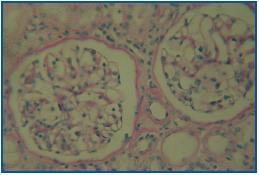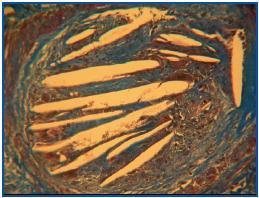Dear Editor:
We would like to present the clinical case of a male patient 64 years of age with a transplanted kidney. He was admitted for study of asymptomatic deterioration of the transplanted organ’s function.
Patient history: arterial hypertension, type-2 diabetes mellitus, dyslipidaemia, severe peripheral vasculopathy, ischaemic cardiopathy.
Advanced chronic kidney disease secondary to cholesterol atheroembolism following a carotid endarterectomy in a periodical haemodialysis programme (PHD). First transplant failed due to intraoperative renal venous thrombosis.
Recipient of second kidney transplant (baseline creatinine 1.8mg/dl). Donor: female 59 years of age with no associated Cardiovascular Risk Factors (CRFs).
Recent history: 15 months after the transplant, a decrease in renal function was detected in a routine check-up. There were no changes to the diuresis rhythm, nor was there any consumption of nephrotoxins or any recent invasive diagnostic procedures.
Complementary tests:
Analytical tests: plasma creatinine 5.5mg/dl, urea 131mg/dl, leukocytosis, normochromic normocytic anaemia, metabolic acidosis and elevated systemic inflammation parameters.
Doppler ultrasound: 12cm kidney, thin cortex, normal resistance indexes.
Renal biopsy: five glomerules with structure intact, without cellular alterations. Permeable capillaries. Tubular atrophy. In arcuate artery 100 micra in diameter, multiple cholesterol crystals occluding the vessel lumen. In the surrounding area, giant multinuclear cells and histiocytes.
Given with the irreversibility of the lesions and the persistence of creatinine clearance under 10ml/min, the patient resumed PHD.
Discussion
The cause was a spontaneous cholesterol atheroembolism in a patient with multiple CRFs and a previous episode of atheroembolism after an emergency treatment procedure. The literature states that in both transplanted and native kidneys, when there is no clear trigger factor and no symptoms on other levels, cholesterol atheroembolism is an occasional finding of a renal biopsy.1-5
Much data shows atheroembolism to be a cause of acute and sub-acute renal failure, and it is associated with a poor vital prognosis in affected patients.1,2,5 It is still an underdiagnosed condition, and in many cases can present as an asymptomatic decrease in kidney function. In some series, it is found in 12% of all autopsies of patients with severe atherosclerosis.2 There is little published data on atheroembolism in transplanted kidneys.3,4
The reviews by Ripple and Takats give a poorer prognosis to patients with early presentation of the atheroembolic event, just after the transplant or in the first year following it; most of these patients lose the transplanted organ.3,4 For many of these patients, the source of the embolism is considered to be the donor, most of whom are older and have associated CRFs, and often receive multiple organ donations. Late cases are associated with a better prognosis, and frequently part of the renal function is recovered. However, our patient suffered a severe initial damage and lost the transplanted organ.
Cholesterol atheroembolism should be considered in the differential diagnosis of asymptomatic decrease in the function of a transplanted kidney.
Figure 1.
Figure 2.










